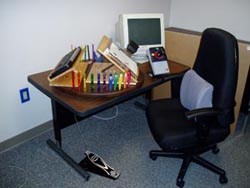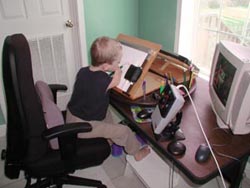Designers: Dan Southam, Brian Goldberg and Mike Scott
Client Coordinator: Barbara Howard, Duke University Hospital
Supervising Professor: Dr. Larry N. Bohs
 Our six-year-old client previously had difficulty completing his homework and working on the computer without adult assistance because he was born with TAR syndrome, resulting in short arms and weakened hands. A custom computer workstation was built that allows him to work at his desk independently. The design consists of a rotating surface that provides easy access to a magnetic writing stand and a wireless keyboard, both with adjustable incline. The client presses and releases a foot pedal to lock the rotating surface in the desired position, while a commercial desk chair with back pad provides appropriate support. Using this device, the client can complete his work and operate the computer independently and comfortably.
Our six-year-old client previously had difficulty completing his homework and working on the computer without adult assistance because he was born with TAR syndrome, resulting in short arms and weakened hands. A custom computer workstation was built that allows him to work at his desk independently. The design consists of a rotating surface that provides easy access to a magnetic writing stand and a wireless keyboard, both with adjustable incline. The client presses and releases a foot pedal to lock the rotating surface in the desired position, while a commercial desk chair with back pad provides appropriate support. Using this device, the client can complete his work and operate the computer independently and comfortably.
How this project helped
The Rotational Workstation will enable our client to complete his homework, paint or draw pictures, and use a computer without adult assistance. The client’s mother commented, “He loves it!! He is using it to make all kinds of stuff, and feels so important having his own desk. There is nothing on the desk he can’t operate, and it works very well.”
The Rotational Workstation includes a rotating surface, adjustable writing stand, wireless keyboard, an adjustable-height desk and a desk chair.
The rotating surface was made from a circular piece of ¾” pine, 2” in diameter, to which a commercial Lazy Susan bearing was attached. A series of holes were drilled near the outer edge of one sector of the desk to accommodate the client’s pens, pencils, and markers.
A commercial adjustable easel was attached to the rotating surface, and a clipboard attached to the easel. A magnetic writing surface was glued to the clipboard, and a foam-padded lever was built to make the clip easy for the client to use. Magnets with small handles and a check memo rail were provided so that the client could secure his writing paper to the clipboard using the clip on the top and magnets on the sides, thus allowing him to draw and erase without tearing the paper.
 The rotating surface was attached via the Lazy Susan bearing to a commercial adjustable-height desk. Thick foam weather-stripping was secured to the edge of the desk to improve the client’s comfort as he leaned over to use the writing stand or keyboard. A commercial desk chair with low ground-to-seat height was found appropriate for the client, after adding a back pad and extra foam cushioning at the rear of the backrest to support his torso while reaching the workstation components.
The rotating surface was attached via the Lazy Susan bearing to a commercial adjustable-height desk. Thick foam weather-stripping was secured to the edge of the desk to improve the client’s comfort as he leaned over to use the writing stand or keyboard. A commercial desk chair with low ground-to-seat height was found appropriate for the client, after adding a back pad and extra foam cushioning at the rear of the backrest to support his torso while reaching the workstation components.
Finally, a locking mechanism was implemented to prevent the Lazy Susan from rotating while one of the two stations was in use. A spring pin was positioned under the desk, and two holes drilled into the bottom surface of the Lazy Susan, according to the desired positions of the keyboard and writing surface. The client could depress a drum pedal, connected to the pin by a bike cable, to disengage the pin while he rotated the surface to an alternate position.
Figure 2 shows the client using the Rotational Workstation. Cost of parts for the device was about $550.